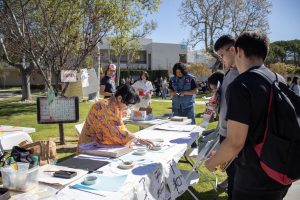Wallflower project exhibits artist’s talk and reception
September 28, 2017
Art professor, Erika Lizée hosted The Wallflower Project Artist’s Talk and Reception on Sept. 20 at Moorpark College. The subject of Janine Brown’s professional solo exhibit, the wallflower, was a term coined during Britain’s Regency era for a woman sitting by the wall at parties, too shy to dance. Lizée put this concept into a modern-day American context when introducing Brown to a room packed full of about 60 people who had gathered for the Talk.
“She highlights the introvert in our society, a group of people [who] are observers, rather than talkers,” said Lizée. “Their quiet nature allows them to be overlooked, and I think unfortunately, they are less valued in this loud, ‘look at me’ society we are living in.”
Brown started her talk telling the audience about her schooling. I majored in craft design at Iowa State University, then moved to New York and studied sportswear design at the Fashion Institute of Technology in New York City (FIT), said Brown. “[At FIT] I did three-dimensional design, using the cyanotype photography process on rice paper, and turning the rice paper into a contemporary kimono.”
Transitioning from art school into a career plunged Brown into the fashion industry during the 90s.
“I worked as a designer for fashion giants like Liz Claiborne and Oscar de la Renta, who became famous in the 1960’s for designing clothing for Jacqueline Kennedy,” she said. Brown interned with the designer two weeks before and during Oscar de la Renta’s Spring runway shows in 1990 and 1991 while attending FIT.
“After FIT, I worked as a designer for Liz Claiborne and the Associated Merchandising Corporation,” she said. “I designed children’s men’s and women’s clothing, textiles and embroideries at AMC.”
Years later, Brown described a conversation she had with an artist friend at a party, who noted how she would go to parties with her husband, and people would pay attention to him, not her, and then realized that she also experienced this same situation at social events with her husband. This inspired Brown to choose wallpaper as one of the two mediums for The Wallflower Project, the other medium being photography.
“This made me think about the stigma of the wallflower, so I did research on it–someone fading into the background,” said Brown.
An artist friend had a book of wallpaper samples, but the samples curved towards the spine of the book, which meant I couldn’t use them, she said. “So I contacted stores in the area, and one was throwing out a collection of discontinued wallpaper samples that I was able to salvage. This made them one of a kind.”
“I started with a cardboard pinhole camera kit, and did double exposures,“I decided to work with black and white because I liked the vintage look of it”.
Brown elaborated on some challenges that this project presented since its inception in 2010.
“Historically I was working with black and white film to produce monochrome portraits, but produced a full color portrait in 2011,” she said.
Around this time Brown put her career on hold to relocate her family from the East coast to the West coast, and move into a new art studio in Santa Monica. After more experimenting, Brown went in a full-on new color direction by 2015.
“When I was in the darkroom I experimented with colored negatives that I printed with black and white chemicals. But I’m not a photographer! The blessing of [this] was not letting the rules of photography hinder me experiment,” she said.
Brown’s experience in photography was not as a photographer but as a fine artist, using photography as a medium to explore.
“In college I used photographic processes on fabrics, then as a full time artist after my kids were born, I started using photography as source material for artwork in soft pastels, watercolor and acrylic paintings,” said Brown. “So in addition to drawing and sketching, I was comfortable with photography although not formally trained in commercial or fine art photography.”
In the Q & A session following the talk, Brown revealed the well-spring of her love for fabrics, dating back to her childhood in rural Iowa.
“During elementary school I used to doodle, and draw on paper, and use my hands. I was also in the 4-H Club for farm kids. I did a lot of sewing and creating. Also, being on a farm there’s not a lot to do, so I did a lot of drawing and painting.”
With this background, the Q & A session highlighted how textiles and craft design seemed like natural paths for Brown to follow, even though her career path as an artist has been a circuitous route.
“[People] asked great questions at the end of the lecture,” said Brown. “I really enjoyed speaking with [them] and others at the reception. After having such a windy journey to becoming an artist – it’s nice to be able to share some of my experiences – good and bad – with the students to hopefully help them on their journey.”
Brown epitomizes the very reason that the Moorpark College Art Gallery director organizes these events.
“I thought the artist talk was very successful,” said Erika Lizée. “We had a wonderful turn out and the students were very engaged and interested in hearing from Janine. I love hearing the paths that artists took to get to where they are today. It’s a different lifestyle being an artist, and these talks show students the possibilities.”
Lizée introduced the Artist’s Talk about eight years ago to feature as a two-part event with the receptions for the professional solo exhibits.
“I wanted students to learn directly from the artists in the formal lecture environment, as well as give them the informal setting at the reception, which gives them one-on-one opportunities to talk to the artist directly while looking at the art in person,” said Lizée.
The reception’s informal setting certainly opened up the conversation.
“I think what [Brown] has done is pretty unique,” said Renae Leclerc, 19, Sociology major. “I really like the concept of the wallflower because I’m shy and quiet. I like the way [Brown] put it together. It’s really creative, and what she’s doing, the photographic process, and the outcome– how it’s almost faded is creative. The shadow shows the meaning behind it– can relate to it.”
“The artist has a lot of experience, and you have to do something new in art to be successful, to stand out,” said Artiom Gevoian, 19, Art major.
“[Brown] took something away from her fashion career and put it into her pieces–the wallpaper and the photographic process.” said Russian-born Gevoian, who emigrated from Armenia about 15 years ago. I am not interested in this, but I can see why everyone else likes it, he said.
“I learned [from the talk] that maybe in the background of your artwork you can add a part of you– something I never thought about until today,” said Gevoian.
For more information on “The Wallflower Project” contact Professor Erika Lizée at [email protected].







